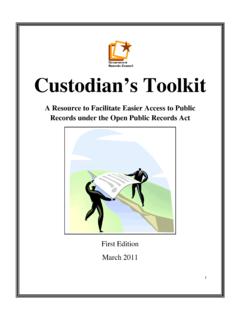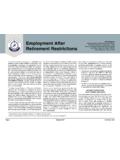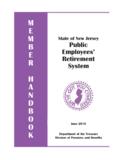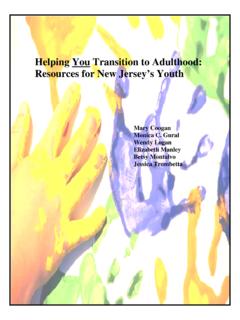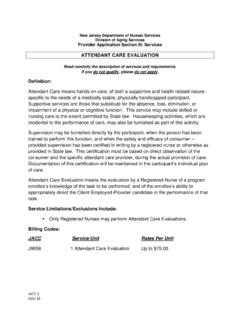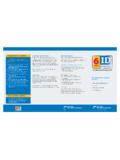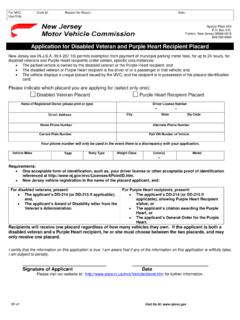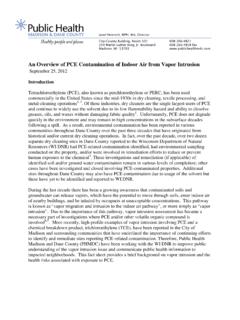Transcription of VAPOR INTRUSION TECHNICAL GUIDANCE - nj.gov
1 NEW JERSEY DEPARTMENT OF. ENVIRONMENTAL PROTECTION. SITE REMEDIATION AND WASTE. MANAGEMENT PROGRAM. VAPOR INTRUSION TECHNICAL GUIDANCE . Indoor Air Soil Gas Ground Water January 2018. Version New Jersey Department of Environmental Protection Site Remediation and Waste Management Program VAPOR INTRUSION TECHNICAL GUIDANCE January 2018. Version 2. ACKNOWLEDGEMENTS. The New Jersey Department of Environmental Protection (Department) VAPOR INTRUSION TECHNICAL GUIDANCE (Version ) document was previously prepared by the Department/Stakeholder VAPOR INTRUSION GUIDANCE Committee in cooperation with the Department VAPOR INTRUSION Committee. The updated VAPOR INTRUSION TECHNICAL GUIDANCE (Version ) was completed by the Department with assistance from the Stakeholder VAPOR INTRUSION GUIDANCE Committee.
2 Department/Stakeholder VAPOR INTRUSION GUIDANCE Committee John Boyer, Chair, New Jersey Department of Environmental Protection Ken Bird, Woodard & Curran Consultants Brian Blum, Langan Consultants Scott Drew, Geosyntec Consultants John Engdahl, Speedway Diane Groth, New Jersey Department of Environmental Protection Andrew Sites, New Jersey Department of Environmental Protection Peter Sorge, JM Sorge, Inc., Environmental Consultants Chad Van Sciver, New Jersey Department of Environmental Protection Additional TECHNICAL Assistance: Gunnar Barr, OBAR Systems Bill Morris, VAPOR Mitigation Sciences Special thanks for the assistance of the following individuals from the Department: Carey Compton Barry Frasco Tracy Grabiak Kathy Kunze George Nicholas Sana Qureshi Paul Sanders Kevin Schick Teruo Sugihara Cover graphic courtesy of the Interstate Technology & Regulatory Council (ITRC).
3 3. DISCLAIMER. The use of any trade names, products or materials in this document does not constitute an endorsement by the State of New Jersey's Department of Environmental Protection (Department). The information in the Department's VAPOR INTRUSION TECHNICAL GUIDANCE (Version ). document is provided free of charge to the public. The State of New Jersey, its agencies and employees assume no responsibility to any person or entity for the use of this information. There are no representations or warranties, expressed or implied, of any kind regarding this information, and any use of this information is made at the risk of the user. Neither the Department nor the State of New Jersey maintains many of the web links and web addresses in the Department's VAPOR INTRUSION TECHNICAL GUIDANCE (Version ).
4 The Department makes no special endorsement for the content of these links, their sites or the views expressed by the sites' publishers. Websites may change or remove their contents at any time. Therefore, the Department cannot guarantee that the material on the referenced websites will be the same as it was when the VAPOR INTRUSION TECHNICAL GUIDANCE (Version ) was developed or even that the links will be available. Trademarks ( , Microsoft Word, Adobe Acrobat) belong to their respective companies. 4. NJDEP VAPOR INTRUSION TECHNICAL GUIDANCE (Version ). January 2018. TABLE OF CONTENTS. ACKNOWLEDGEMENTS .. 3. DISCLAIMER .. 4. TABLE OF CONTENTS .. 5. EXECUTIVE SUMMARY .. 9.
5 INTRODUCTION .. 10. Intended Use of this TECHNICAL GUIDANCE .. 10. Overview of this GUIDANCE .. 10. Department-Generated Variances .. 12. GUIDANCE Updates .. 12. RECEPTOR EVALUATION & SCREENING (STEPS 1 AND 2) .. 13. VI Triggers .. 13. Trigger Distances .. 13. Dissolved Ground Water Exceedance of GWSL .. 14. Presence of Free and Residual Product .. 15. Soil Gas Exceedance of SGSL .. 15. Indoor Air Exceedance of IASL or Rapid Action Levels .. 16. Presence of Ground Water Contamination or Free Product in a Wet Basement or Sump .. 16. Presence of Methanogenic Conditions .. 16. Other Conditions That May Impact Human Health and Safety .. 16. Volatile Soil 16. VAPOR INTRUSION Screening Levels.
6 17. VI Receptor Evaluation (Step 1) .. 17. Initial Data Gathering .. 17. Building and Structures .. 18. Conceptual Site Model .. 19. Preferential Pathways .. 19. Landfills and Methane Gas .. 20. Petroleum VI Screening (Step 2) .. 21. VAPOR INTRUSION INVESTIGATION (STEP 3) .. 22. Preparing for a VAPOR INTRUSION Investigation .. 22. Investigative Approach .. 22. Access .. 23. Iterative Nature of VI 24. Field Analysis in Support of VAPOR INTRUSION Investigations .. 25. Ground Water Investigation and Sampling .. 27. Saturated Zone Features Affecting VAPOR INTRUSION .. 28. Use of Pre-Existing Ground Water Data .. 31. Obtaining New Ground Water Data to Evaluate the VI Pathway.
7 31. Soil Gas Sampling .. 33. Sub-Slab Soil Gas Sampling .. 34. Alternative Soil Gas Sampling .. 38. Conducting a Building Walkthrough and Survey .. 41. Identification of Potential Background Sources .. 42. Recognition of Points of VAPOR INTRUSION in a Building .. 42. Identification of Possible Sample Locations .. 42. 5. NJDEP VAPOR INTRUSION TECHNICAL GUIDANCE (Version ). January 2018. Informing Occupants about VAPOR INTRUSION and Sampling 43. Indoor Air 43. 43. Investigative 44. 46. Sample Duration .. 47. Number and Location of Samples .. 47. Sample Events .. 49. Methane Investigations and Analytical Methods .. 50. Other Investigative Tools .. 51. Data Usability .. 51. Investigative Reporting Requirements.
8 52. MULTIPLE LINES OF EVIDENCE AND DATA EVALUATION .. 54. Background Indoor Air 54. Components of a Multiple Lines of Evidence Approach .. 55. Primary 55. Secondary Factors .. 58. Other Lines of 59. Data Evaluation .. 59. Background Sources .. 59. Ground Water Samples .. 59. Multi-Depth Ground Water Contaminant Data .. 60. Sub-Slab Soil Gas Samples .. 61. IA Samples from the Basement .. 61. Multiple Indoor Air Samples from Different Floors .. 62. Indoor Air and Sub-Slab Soil Gas Samples .. 62. Assessing Background Contamination from Operational Activities .. 63. Compliance .. 64. Official Notification .. 64. PETROLEUM HYDROCARBONS .. 65. 65. Biodegradation .. 66. VI Investigation.
9 66. Alternative Approaches .. 67. Petroleum Vertical Screening Distance .. 67. Discharges of No. 2 Fuel Oil / Diesel Fuel Oil & Heavier Petroleum Fractions .. 72. VAPOR INTRUSION MITIGATION .. 74. Initial Response Actions Overview and Timeframes .. 74. Response Action Categories .. 74. Specific Response 76. Mitigation Methods .. 78. Active Subsurface Depressurization Systems .. 78. Passive Subsurface Depressurization Systems .. 79. Sub-Slab Ventilation Systems (SSVS).. 80. Alternative Mitigation Methods .. 80. Mitigation System Design and Construction .. 81. System Design and Installer Qualifications .. 81. Pre-Mitigation Diagnostic Testing .. 81. Sealing VAPOR 83. Gas VAPOR Barriers.
10 84. Construction and Electrical Permits .. 86. Air Permits .. 86. Buildings with Existing Radon Systems .. 86. 6. NJDEP VAPOR INTRUSION TECHNICAL GUIDANCE (Version ). January 2018. Post-Mitigation Activities .. 86. Institutional and Engineering Controls .. 86. System Commissioning (Post-Mitigation Diagnostic Test).. 88. Verification Sampling .. 90. Assessing the Impact of Background Contamination and Operational Activities .. 91. Engineered and VI Response Action Report .. 92. Monitoring and Maintenance (M&M) .. 93. Variations in Baseline Parameters .. 93. Long-Term Monitoring .. 96. VI Mitigation Termination .. 96. REFERENCES .. 98. TABLES. Table 3-1 Overview of Data Quality Objective Level Classifications for VI Investigations.
